|
The Hat That Won the West
by Bob Brooke
Mention Stetson hats and images
of cowboys and adventure spring to mild—cowboys driving cattle up a
dusty trail, cowboys "bustin' broncos," cowboys performing stunts in
Buffalo Bill's Wild West. John B. Stetson's famous "Boss of the
Plains" cowboy hats, and all the high crowned, wide brimmed, soft
felt western hats that followed, are intimately associated with the
cowboy image. They have long been essential tools for anyone working
in the intense heat or stinging cold of the open range.
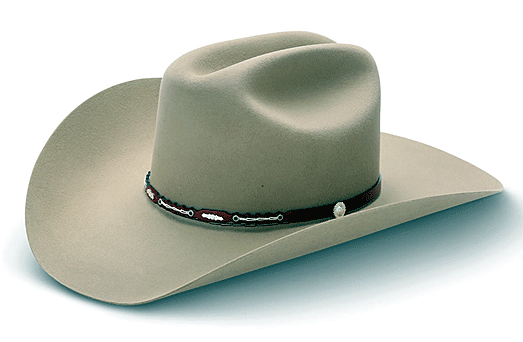
But the dusty cowboy hat is only part of the story. Stetson hats,
both western and dress, came in all shapes and sizes. There was a
Stetson for just about every occasion. Both cowboys and city
slickers wore Stetsons produced at the John B. Stetson Company
factory In Philadelphia from circa 1870 to 1970.
Who Wore Stetson Hats?
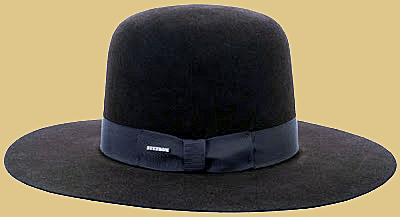 Back
in the 1870s when John Batterson Stetson started selling his hats,
no one went bare-headed and almost anybody could tell you something
about a man's social status, attitudes and beliefs, upbringing and
marital status by the hat he wore. Back then, wearing a Stetson was
a status symbol. These high quality hats were expensive. From the
moment Stetson started producing his trademark "Boss Of The Plains"
western hat between 1865 and 1870, he sold it for $5 to $30
dollars—steep prices for the 1860s and 1870s—depending on the
quality of the felt involved. Back
in the 1870s when John Batterson Stetson started selling his hats,
no one went bare-headed and almost anybody could tell you something
about a man's social status, attitudes and beliefs, upbringing and
marital status by the hat he wore. Back then, wearing a Stetson was
a status symbol. These high quality hats were expensive. From the
moment Stetson started producing his trademark "Boss Of The Plains"
western hat between 1865 and 1870, he sold it for $5 to $30
dollars—steep prices for the 1860s and 1870s—depending on the
quality of the felt involved.
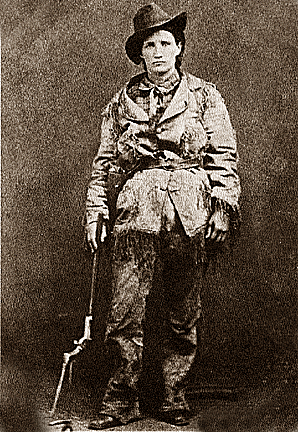 Famous
names from the late 19th and early 20th centuries wore Stetsons,
including Buffalo Bill Cody, Calamity Jane, Will Rogers, and Annie
Oakley. Legend has it General George A. Custer rode into the Battle
of Little Big Horn wearing a Stetson. The Texas Rangers were the
first American lawmen to officially adopt a Stetson hat as part of
the uniform, although many others would follow. The Royal Canadian
Mounted Police, police forces in over 30 American states, members of
the National Park Service, Border Patrol, Army and Air Force Drill
and Rifle Team, and Marine Corps all donned various Stetson styles. Famous
names from the late 19th and early 20th centuries wore Stetsons,
including Buffalo Bill Cody, Calamity Jane, Will Rogers, and Annie
Oakley. Legend has it General George A. Custer rode into the Battle
of Little Big Horn wearing a Stetson. The Texas Rangers were the
first American lawmen to officially adopt a Stetson hat as part of
the uniform, although many others would follow. The Royal Canadian
Mounted Police, police forces in over 30 American states, members of
the National Park Service, Border Patrol, Army and Air Force Drill
and Rifle Team, and Marine Corps all donned various Stetson styles.
But what really boosted the popularity of Stetson hats in the 20th
century were the movie stars who wore them, including Tom Mix,
Douglas Fairbanks, Gene Autry, Roy Rogers and Dale Evans.
Western and Dress Hats
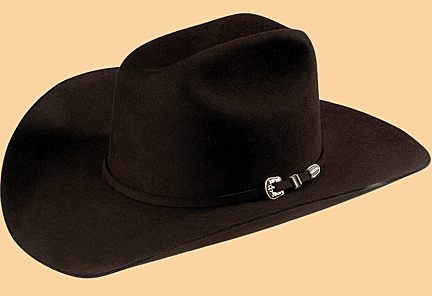 Stetson
hats came in two categories—western hats and dress hats. Western
hats were also known as soft hats, stockmen's hats, or cowboy hats.
While there have been many western hat shapes made over the years,
identified with colorful names such as Boss of the Plains, Austin,
Baden Powell, and Lincoln, these hats didn’t change their shapes
nearly as often as dress hats. In 1901, a man could purchase a
western hat in black, blue-black, otter belly, side and back nutria,
the last three being natural fur colors. Stetson
hats came in two categories—western hats and dress hats. Western
hats were also known as soft hats, stockmen's hats, or cowboy hats.
While there have been many western hat shapes made over the years,
identified with colorful names such as Boss of the Plains, Austin,
Baden Powell, and Lincoln, these hats didn’t change their shapes
nearly as often as dress hats. In 1901, a man could purchase a
western hat in black, blue-black, otter belly, side and back nutria,
the last three being natural fur colors.
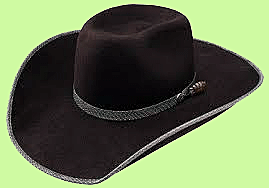 Depending
on the method used to make a hat, hat brims could have a bound,
welted, or a "raw" edge. Also, the edge could be folded, or "pencil
rolled." In that case, Stetson took an oversized edge and doubled it
back and turned it into the crown. After pressing, it formed a soft,
rounded edge and a double brim. Depending
on the method used to make a hat, hat brims could have a bound,
welted, or a "raw" edge. Also, the edge could be folded, or "pencil
rolled." In that case, Stetson took an oversized edge and doubled it
back and turned it into the crown. After pressing, it formed a soft,
rounded edge and a double brim.
A bound edge had a thin strip of material sewn over the outer edge
of the hat brim. This binding finished the edge and helped maintain
the brim's shape, holding the curl, or “snap." The binding was also
decorative. Binding color and width could affect the overall look of
the hat. A wide binding made the brim look narrower than it was and
was an added expense. Narrow bindings made brims look wider. Lighter
colored bindings made dark hats look lighter and vice versa.
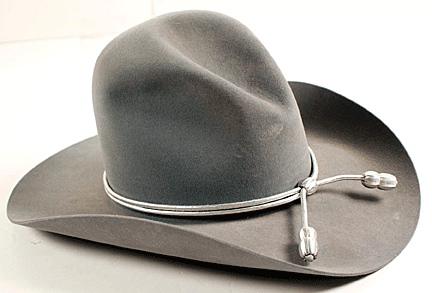 Various
stitching styles were employed to fasten the binding to the brim.
The regular or through stitch is visible on both sides of the brim.
The concealed stitch showed no stitching on the outside of the
rolled brim. There were also ornamental stitches such as the saddle
stitch. Finally, there was the hand-sewn binding which was labor
intensive and time consuming. Various
stitching styles were employed to fasten the binding to the brim.
The regular or through stitch is visible on both sides of the brim.
The concealed stitch showed no stitching on the outside of the
rolled brim. There were also ornamental stitches such as the saddle
stitch. Finally, there was the hand-sewn binding which was labor
intensive and time consuming.
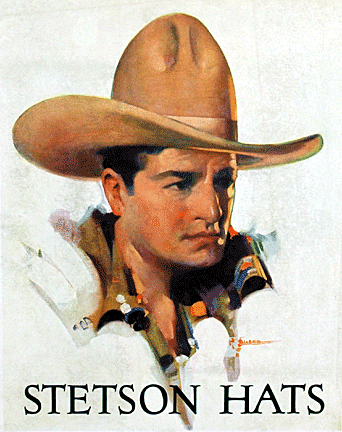 The
less costly "boss raw edge" required no binding around the outer
edge of the brim to maintain its shape and keep a clean, unraveled,
edge. For a finishing touch the raw edge could be slanted or
rounded, lending additional strength to the brim. The
less costly "boss raw edge" required no binding around the outer
edge of the brim to maintain its shape and keep a clean, unraveled,
edge. For a finishing touch the raw edge could be slanted or
rounded, lending additional strength to the brim.
This is a Stetson hand finishing technique. Hats made of nutria or
beaver felt were curled and shaped at the kettle, applying hot
water. to the brim and carefully curling it. This process created a
hat that would retain its shape under extreme weather conditions. No
binding was needed to keep the curl in the brim. Kettle finished
brims ranged from heavily to slightly curled. Style names of hats
finished in this way included Richmond, Sorento, Panama, Graeco,
Express, Niagara, Columbia, Denver, Dakota and Buffalo Bill.
Hat Linings
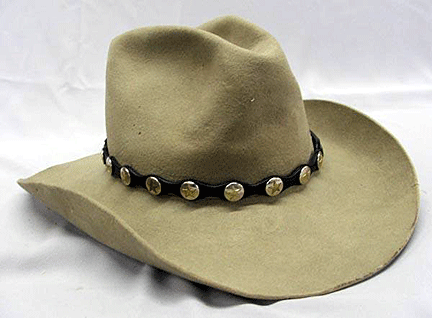 Early
on Stetson used fine satins for their hat linings. To keep them in
place, craftsmen sewed them in at the base of the brim and tailored
them to fit the inside of the hat exactly. The better the skill of
the craftsman, the better the lining would fit. Early
on Stetson used fine satins for their hat linings. To keep them in
place, craftsmen sewed them in at the base of the brim and tailored
them to fit the inside of the hat exactly. The better the skill of
the craftsman, the better the lining would fit.
Hatbands
Hatbands encircled the crown just above the brim. Early hatbands
were adjustable leather belts used to adjust the hat's fit. Stetson
used woven silver or gold wire for their decorative hatbands. A
rattlesnake skin sometimes replaced the leather band. Later, Stetson
made bands of silk and were merely decorative.
Qualities of Hats
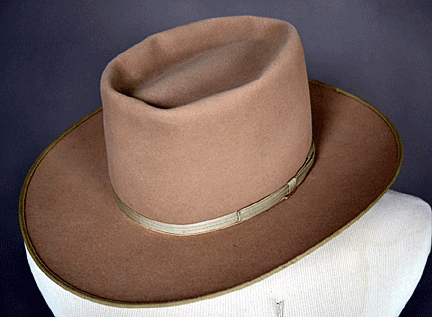 Stetson
used the fur from American and Canadian beaver and muskrat, “nutria”
from the Argentine coypu, and fur from the hare from Continental
Europe and the Scottish and English coney, a European rabbit, to
make its felt. The best quality fur from the beaver, muskrat and
coypu was the belly fur. The back fur from hares and coneys was the
best. The higher the quality of the fur used to make the felt, the
more expensive the hat made from that felt would be. According to
the early catalogs, the quality of the felt and the size of the brim
were the prime considerations in pricing Stetson hats. Stetson
used the fur from American and Canadian beaver and muskrat, “nutria”
from the Argentine coypu, and fur from the hare from Continental
Europe and the Scottish and English coney, a European rabbit, to
make its felt. The best quality fur from the beaver, muskrat and
coypu was the belly fur. The back fur from hares and coneys was the
best. The higher the quality of the fur used to make the felt, the
more expensive the hat made from that felt would be. According to
the early catalogs, the quality of the felt and the size of the brim
were the prime considerations in pricing Stetson hats.
Trademarks and Labels
 A
hat merchant familiar with Stetson's trademarks could tell at a
glance how much a dozen hats with a specific mark would cost. The
company offered to print the marks of retailers onto the sweatbands
of hats sold in their stores. A
hat merchant familiar with Stetson's trademarks could tell at a
glance how much a dozen hats with a specific mark would cost. The
company offered to print the marks of retailers onto the sweatbands
of hats sold in their stores.
Cloth labels also appear inside Stetson hats. These labels identify
the retail merchants selling Stetson hats, using their individual
trade-marks. Unlike trademarks, cloth labels rarely appear in
garments pre-dating 1920. Stetson produced their hats from women
—most bearing cloth labels, with a few early western exceptions,
between 1930 and the early years of the 1950s. A label can also be
helpful in dating the hat in which it’s found, provided a collector
knows how long the merchant listed on the label was in business.
<
Back to More Antique Spotlights
Next Article >
|
